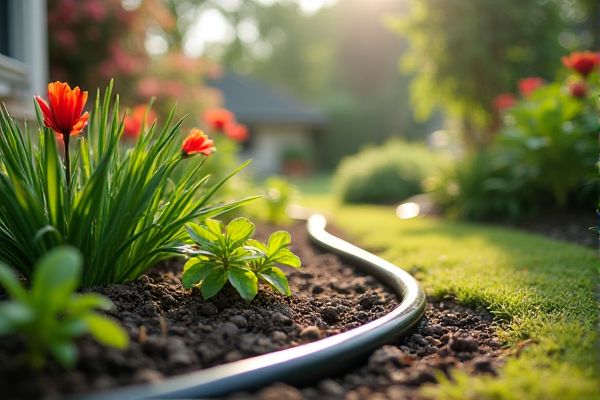
Drip irrigation delivers water directly to plant roots through a network of tubes and emitters, maximizing water efficiency and minimizing evaporation, while soaker hoses release moisture evenly along their length, ideal for watering garden beds without disturbing the soil. Discover which method suits your gardening needs best by reading the rest of the article.
Table of Comparison
| Feature | Drip Irrigation | Soaker Hose |
|---|---|---|
| Water Delivery | Slow, targeted drip emitters | Water seeps evenly through porous hose |
| Water Efficiency | High efficiency, minimal waste | Moderate efficiency, some runoff |
| Installation Complexity | Moderate to high, requires emitters and tubing | Simple, lay hose and connect to water source |
| Coverage Area | Customizable zones for precise watering | General watering along hose length |
| Maintenance | Requires emitter cleaning and system checks | Less maintenance, occasional unclogging |
| Cost | Higher initial setup cost | Lower initial cost |
| Best Use | Garden beds, container plants, row crops | Dense garden beds, perennials, shrubs |
Introduction to Drip Irrigation and Soaker Hose
Drip irrigation delivers water directly to plant roots through a network of tubes, emitters, and valves, optimizing water efficiency and reducing evaporation. Soaker hoses release water along their porous surface, allowing water to seep slowly into the soil, ideal for garden beds with closely spaced plants. Choosing between drip irrigation and a soaker hose depends on your garden's layout, water conservation goals, and plant watering needs.
How Drip Irrigation Works
Drip irrigation delivers water directly to plant roots through a network of tubes and emitters, minimizing evaporation and runoff. Each emitter releases a controlled, slow flow of water, ensuring consistent soil moisture and efficient water use. This targeted watering method promotes healthier plant growth while conserving water compared to traditional watering systems.
How Soaker Hoses Work
Soaker hoses work by releasing water slowly through tiny pores along their length, allowing moisture to seep directly into the soil at a consistent rate. This targeted delivery minimizes evaporation and runoff, making soaker hoses highly efficient for watering garden beds and shrubbery. Your plants benefit from deeper root hydration as the water penetrates gently and evenly into the soil.
Water Efficiency Comparison
Drip irrigation systems deliver water directly to the plant roots through a network of tubes and emitters, resulting in water efficiency rates up to 90%, minimizing evaporation and runoff. Soaker hoses release water along their entire length, providing moderate water efficiency around 60-70%, but they tend to lose more water to evaporation and can oversaturate soil if not monitored carefully. Choosing drip irrigation optimizes water conservation in landscapes and gardens by targeting specific plant zones, reducing overall water usage significantly compared to soaker hoses.
Installation Process and Complexity
Drip irrigation systems require precise layout planning and multiple components such as emitters, tubing, and connectors, making installation moderately complex and time-consuming. Soaker hoses involve straightforward placement along plant beds with minimal adjustments, simplifying setup and reducing installation time. The need for pressure regulation and system calibration in drip irrigation contrasts with the simpler, plug-and-play nature of soaker hose installation.
Cost Analysis: Drip Irrigation vs Soaker Hose
Drip irrigation systems generally incur higher initial costs, averaging $200 to $500 depending on garden size, due to complex tubing and emitters, while soaker hoses typically cost between $15 and $50, making them more budget-friendly for small-scale watering. Maintenance expenses for drip irrigation can be moderate, involving occasional emitter replacement and filter cleaning, whereas soaker hoses may require more frequent replacement due to clogging or wear, impacting long-term costs. Overall, drip irrigation offers greater water efficiency and targeted delivery, potentially reducing water bills, while soaker hoses offer a simpler, lower-cost option with less precise water use.
Maintenance Needs for Each System
Drip irrigation systems typically require more maintenance due to the risk of clogging in emitters and tubing, necessitating regular flushing and filter cleaning to ensure consistent water flow. Soaker hoses demand less frequent upkeep but should be checked for cracks, leaks, and blockages caused by soil or debris buildup to maintain optimal water distribution. Both systems benefit from seasonal inspections to prolong lifespan and maximize irrigation efficiency.
Best Applications and Suitable Gardens
Drip irrigation systems excel in precise water delivery for vegetable gardens, flower beds, and container plants, making them ideal for landscapes requiring targeted watering and conservation. Soaker hoses perform best in established garden beds or densely planted areas where uniform soil moisture is desired without the complexity of emitters. Your garden's layout and plant types determine whether the precise control of drip irrigation or the broader coverage of soaker hoses will most effectively support healthy growth.
Environmental Impact and Sustainability
Drip irrigation systems deliver water directly to the plant roots with minimal evaporation and runoff, significantly reducing water waste and promoting sustainable water use. Soaker hoses also conserve water by slowly releasing moisture into the soil, but they may cause uneven watering and increased evaporation compared to drip emitters. Choosing drip irrigation helps you maximize water efficiency and minimize environmental impact, supporting eco-friendly gardening practices.
Choosing the Right Watering System for Your Garden
Drip irrigation provides precise water delivery directly to plant roots, conserving water and reducing weed growth, while soaker hoses evenly distribute water along the hose length, ideal for densely planted beds. Your choice depends on garden size, plant types, and water efficiency goals, with drip systems often preferred for targeted watering and soaker hoses for simplicity and broader coverage. Both systems help maintain healthy plants by ensuring consistent moisture levels with minimal evaporation.
 homyna.com
homyna.com